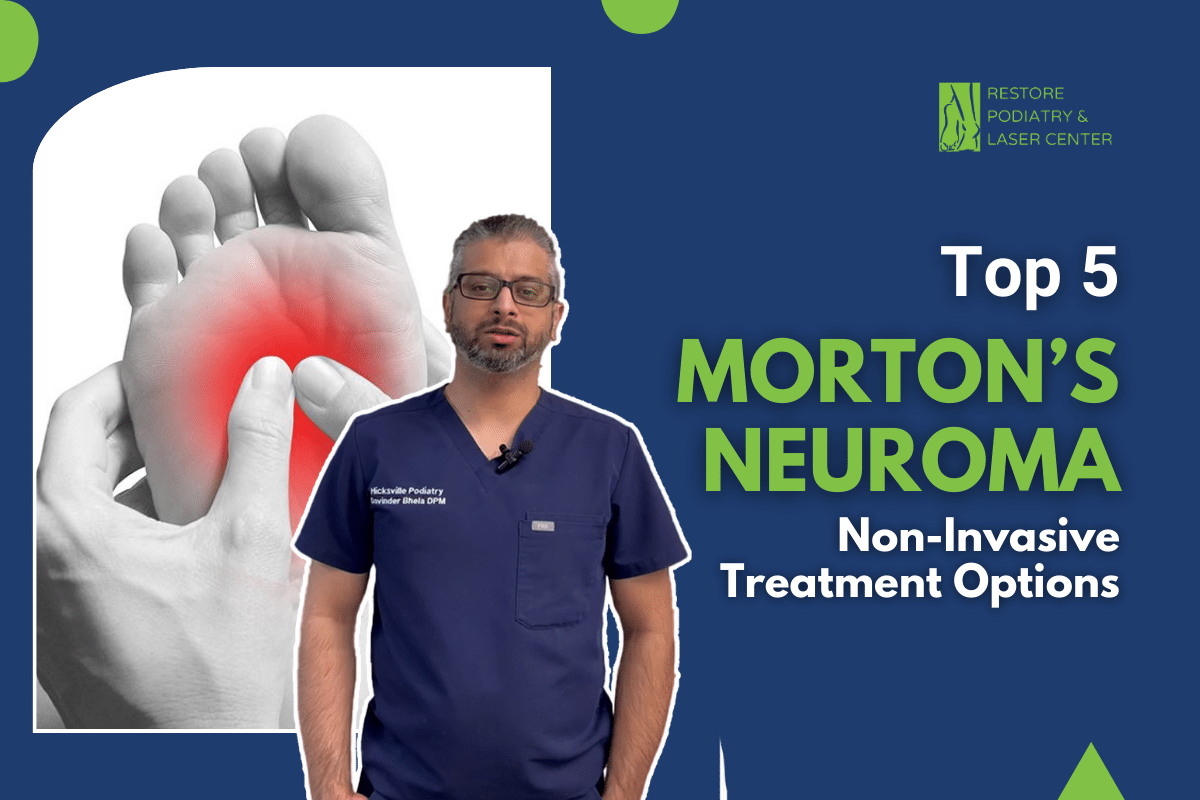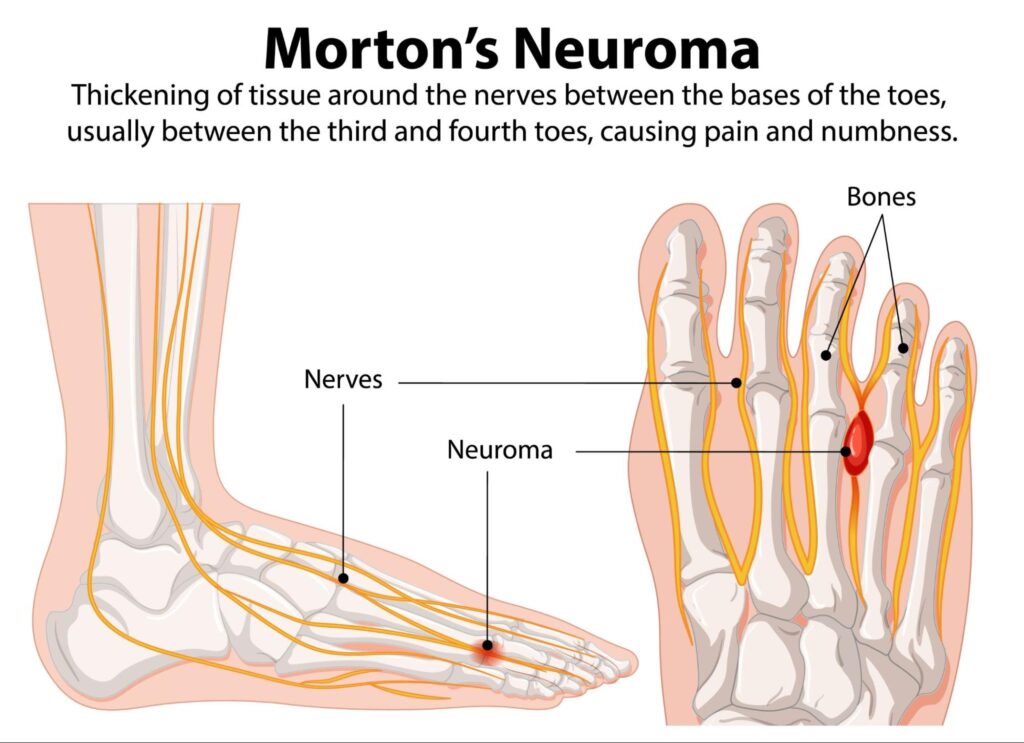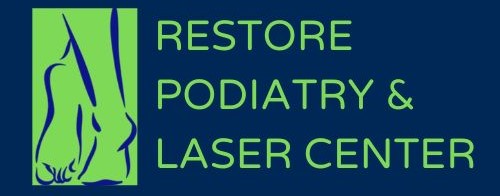Top 5 Morton’s Neuroma Non-Invasive Treatment Options

Morton’s neuroma is a painful inflammation of the tissue around one of the nerves in your feet. This thickening affects the ball of your feet and is commonly found between your third and fourth toes. Morton’s neuroma, also sometimes referred to as the Interdigital neuroma, might feel like you are always stepping on a small pebble.
Morton’s neuroma is not a tumor. It is just the thickening of existing nerve tissue caused by compression and irritation. High heels or tight shoes are often the culprits behind it. Symptoms might include a sharp stabbing pain in the foot and a burning sensation. Some have complained about numbness and tingling associated with Morton’s Neuroma.

People suffering from Morton’s neuroma experience relief when they switch to lower heels and more relaxing footwear. But that is not a permanent solution. Let us explore the top 5 non-invasive treatments for neuroma.
Treatment options for Morton’s Neuroma
Before proceeding with any treatment plans, your podiatrist will conduct a full clinical examination. An X-ray is likely required to rule out any other common causes of your foot pain.
If your podiatrist suspects Morton’s neuroma, you will be provided several different treatment options to get you pain-free again. Your individualized treatment plan depends largely on the amount of pain you are experiencing.
1. Class 4 laser therapy
Class 4 Laser Therapy is an increasingly popular non-invasive treatment for Mortons’s neuroma. A high-intensity light energy is delivered deeply into the tissue, whose energy stimulates cellular activity, promoting blood flow to reduce inflammation.
Class 4 Laser Therapy reduces pain by blocking the nerve signals and decreasing the pain-inducing chemicals produced in the body. It enhances the body’s natural healing process by promoting cell regeneration and improving tissue repair.
This therapy lasts about 5-15 minutes per session, depending on the severity of your condition. No incisions or needles reduce the risk of infections in the affected area, making it a great option for people looking for a noninvasive procedure. However, not everyone is suitable for this procedure, so consult your podiatrist before considering this option.
2. High Dose Intensity Laser Therapy
Like Class 4 Laser Therapy, High Dose Intensity Laser Therapy (HDILT) also uses powerful lasers to deliver concentrated light energy deep into the tissue. HDILT uses higher power settings, above 10 watts, with deeper tissue penetration and potentially faster sessions.
The high-intensity light penetrates the skin and even muscles, tendons, and joints. It stimulates cellular activity and promotes the release of endorphins, which is a natural pain-relieving compound. This process reduces pain and helps speed up the natural healing of affected tissues.
HDILT is used for severe and chronic conditions requiring higher energy delivery. This is suitable for conditions that haven’t responded well to other forms of laser therapy.
3. Restore Podiatry Exclusive – Nd:Yag Laser Therapy
The Nd:Yag Laser treatment uses a Neodymium-Doped Yttrium Aluminum Garnet laser to treat Morton’s neuroma. The laser operates at a wavelength of 1064 nm, which penetrates deep into the tissue without getting heavily absorbed by the skin melanin.
The laser selectively heats and coagulates the inflamed tissues around the affected nerve without affecting the surrounding tissues and structures.
It is often a safer option for darker skin tones and effective targeted treatment without significant surface damage because of its low absorption and deep targeted penetration characteristics to relieve foot pain.
4. Radial Shockwave Therapy
Radial Shockwave Therapy (RSWT) uses high-energy acoustic waves delivered to the affected area through a handheld device. The waves stimulate biological response in the tissues surrounding the neuroma. The shockwaves help decrease nerve sensitivity in feet by blocking the nerve signals to the brain.
The acoustic wave used in RSWT increases the blood flow, enhancing nutrient delivery and waste removal. This process promotes tissue regeneration in the affected area. This non-invasive treatment option for Morton’s neuroma helps break down calcification, relieving pressure on the nerve.
RSWT requires multiple sessions, which are usually a week apart. It’s important to consult an neuroma specialist podiatrist to determine if RSWT is appropriate for your specific foot condition.
5. Restore Podiatry Exclusive: Focused Shockwave Therapy
Focused Shockwave Therapy (FSWT) uses acoustic waves concentrated on a specific focal point within the tissue. Contrary to the broader spectrum of RSWT, FSWT is more precise and localized, reducing the impact on the surrounding healthy tissues.
The focused nature of the energy delivered in FSWT allows deeper penetration for inflammation located deep. Where RSWT can reach 3-5 cm, FSWT can penetrate up to 12 cm, which is effective in treating musculoskeletal problems, such as the nerve tissue in Morton’s neuroma.
In Focused Shockwave Therapy, treatments are generally shorter and fewer due to their high intensity and focus. Patients might need around 5-8 sessions before they see significant results compared to 6-10 sessions for RSWT.
Wrapping Up…
There are multiple non-invasive therapies available that can help you on your journey to a painless foot. Consult your healthcare provider to know which one suits the best for your condition.
Book Your Appointment
Restore podiatry has a high success rate for shrinking Morton’s neuroma naturally with our 5 highly effective non-surgical treatments. Call us today. Experience life without nerve pain.
 Laser Treatment For Foot Neuroma at Restore Podiatry
Laser Treatment For Foot Neuroma at Restore Podiatry
Our experienced board-certified podiatrist, Dr. Bhela, at Restore Podiatry, customizes a treatment program that best meets your needs, schedule, and budget.

